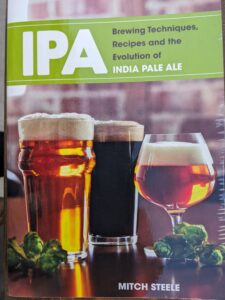Folkways Brewing is a small craft beer brewery just a couple of blocks from the Kiba MOA (Art Museum) whose IPA I really like. It’s not too far from home, but far enough away that I usually try to tie my visits with some other errand, such as shopping at Conan, the home center. One day while there I happened to look at the books they have on a small book shelf and noticed a title that caught my eye, Mitch Steele’s IPA: Brewing Techniques, Recipes, & the Evolution of India Pale Ale. I ended up reading the entire book, one beer at a time over the course of close to a year. And I learned a lot about IPAs, both the history of the brew as well as more technical things about making it from Steele, who formerly brewed for Stone Brewing in San Diego, a brewery famous for making ultra-hoppy IPAs. And as I often do when I read a book, when I was finished, or maybe as I was reading it (I don’t really now), I looked at the footnotes and the bibliography, which is where I leaned of another book on IPAs, Pete Brown’s Hops and Glory: One Man’s Search for the Beer That Built the British Empire, a book written from a completely different perspective, from that of a journalist who specializes in beer and travel. Together they made for a great lesson on India Pale Ale.

Steele’s book is full of IPA recipes and brewing records, especially regarding the hops used in making IPA back in its birthplace, Burton, England. Lots of technical stuff in the book that might not be for the casual beer fan reader. But also all of the basics, especially how IPA was brewed using lightly roasted malt (a first at the time) and preserved to withstand the long voyage from London to Brits posted abroad in India where it was too hot to brew beer. The water in Burton had just the right mineral content to make clear brews, unlike the hazy IPAs that have become popular recently around the world. The beers were aged in wooden casks for up to eighteen months before being loaded on sailing ships for another six months. Due to the risk of the casks exploding from rough seas, they were generally not carbonated until reaching India.

Brown’s book takes a different approach to the story of IPAs by combining his two specialties, writing about beer and travel. In short, Brown starts his story by traveling to the Great American Beer Fest in Colorado and drinking a Bridgeport IPA (from my home city of Portland, Oregon), his first ever IPA; at the time, no IPAs were being made in the UK. Back home. Back home he gets the crazy idea of having a batch of IPA made in Burton (by Coors, of all companies!), then carrying a keg of it to India, not by air but by sea, just like in the days of old. What follows are chapters that alternate between IPA and British colonial history and the adventures and travails he undergoes in trying to deliver a cask of IPA to India.
He ultimately succeeds in his undertaking, and somehow managed to stay married despite it all. Meanwhile, Steele has moved on from Sand Diego to the American Southeast where he brews for a small chain of craft breweries.